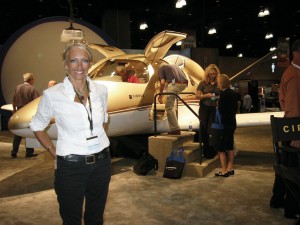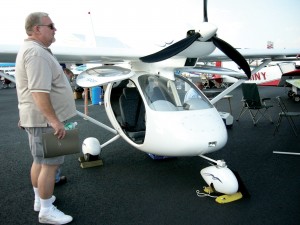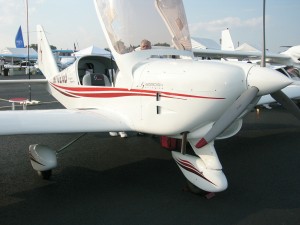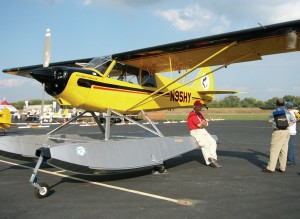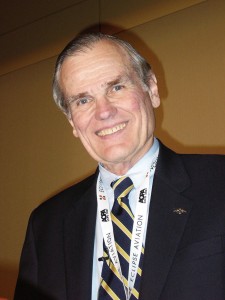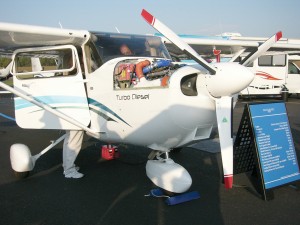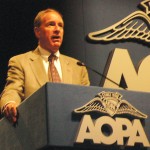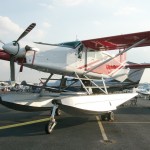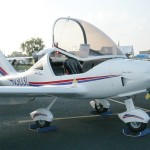By Jack Elliott
The Aircraft Owners and Pilots Association Expo touched down at a new location on Oct. 4, setting a new East Coast attendance record—nearly 10,000—in the process. The location of Hartford, Connecticut’s capital, proved to be an ideal choice.
The beautiful, three-year-old Hartford Convention Center hosted the exhibit hall. The static exhibit was at Hartford-Brainard Airport (HFD), located three miles from the convention hall and just a few miles from Bradley International Airport (BDL) in Windsor Locks.
AOPA Expo is comprised of four major elements. Daily general sessions provide an update on what’s going on in the world of general aviation. Dozens of seminars take place on virtually every subject of interest to pilots, from instrument flying, medicals and glass cockpits to light sport aircraft and very light jets.
A third ingredient is the exhibit hall. There’s so much to see and learn that it takes more than one visit, so most attendees walk through the exhibit hall many times.
The last element is the party atmosphere, providing great entertainment and an opportunity to make new friends. That atmosphere puts conventioneers in an upbeat mood.
Issues discussed
The number one issue on every pilot’s mind is user fees. The U.S. House passed an FAA reauthorization bill that does not include user fees. There’s hope the Senate will follow suit. Six months ago, the situation didn’t look promising. The airlines, many of which recently emerged from bankruptcy, spent huge sums of money trying to pass a user fee through Congress in order to reduce their taxes and put a bigger burden on GA.
The airlines ran stories in their in-flight magazines blaming GA for the increasing number of delays and sent letters to their most active frequent flyers. Nevertheless, through the colossal efforts of the GA community, led in large measure by AOPA President Phil Boyer and NBAA President Ed Bolen, the David and Goliath matchup began to shape up more and more like the legendary biblical tale.
Boyer pointed out that while the airlines blame GA for their delays, the real causes are weather and the airlines’ own scheduling practices. Boyer also said that GA accounts for only four percent of airline delays, although the airlines have spent a tremendous amount of money and effort trying to create the impression that GA alone was responsible. GA proponents have made tremendous progress under extremely difficult conditions, but Boyer noted that the fight isn’t over yet.
Although the user fee battle is looking promising for GA, perhaps the most astounding of AOPA’s many accomplishments took place in San Diego, Calif. A developer planned to build a 12-story office building seven-tenths of a mile from Montgomery Field Airport (MYF). The FAA called the building a hazard to aerial navigation, and the city attorney adamantly opposed the project. That didn’t deter the developer; construction proceeded on the structure.
Richard Beach, an AOPA Airport Support Network volunteer, met with representatives of federal, state and city officials in an effort to stop the construction. Beach continued his contacts with government officials and provided information to the press and local aviation community. Due in large measure to his efforts, the developer took down the top two stories of his structure and cancelled construction of two other planned buildings.
Another outstanding example of saving an important airport was the rescue of Albert Whitted Airport (SPG) in St. Petersburg, Fla. Developers planned to build high-rise buildings on the airport, located on the coast, thereby cutting off the view of the Gulf of Mexico from existing residents. After completing a survey and finding out the majority of the residents were senior citizens, AOPA initiated a campaign illustrating how the construction of those buildings wasn’t in the residents’ best interest. The issue was put on the ballot and the question of closing the airport drew a 78 percent “No” vote. This achievement also came about with the help of an Airport Support Network volunteer.
Jack Olcott, one of the leading authorities on very light jets and the former president of NBAA, offered a seminar on VLJs in which he discussed the issues of insurance and training. Since price and performance parameters for VLJs are so attractive, they elicit much interest from piston pilots wanting to enter the world of jets.
This creates two major concerns. Insurance companies are being very cautious, since statistics aren’t available on which to base rates. There are also questions about training regimens to introduce pilots to this new world of flying. The seminars included a pinch-hitter course for non-pilots (mostly spouses), providing them with basic information that will enable them to be helpful with cockpit chores.
AOPA puts a strong emphasis on aviation safety. Bruce Landsberg, executive director of the AOPA Air Safety Foundation, pointed out at one general session that AOPA offers 20 online safety courses. He said 13,000 courses are completed every month. He warned that easily avoidable problems, like running out of gas, cause many accidents.
On exhibit
AOPA hosted more than 500 exhibits. Hundreds of aviation products, many of them undreamed of only a few years ago, elicited much interest from the aviation-minded crowd.
Sixty aircraft were on display. The flight line at the static exhibit included some new names to the light-sport aircraft category, like the StingSport, Gobosh G-700S, Elitar-Sigma and T-211 Thorpedo LP. Cessna displayed the Skycatcher in the convention hall. The company has already booked 850 orders and expects certification on the 100-hp aircraft in 2009; first deliveries will be shortly thereafter. The aircraft will hold 24 gallons of fuel and burn four gallons an hour.
Among the VLJs on exhibit were the Eclipse 500, Epic Victory and Cessna Citation Mustang. A Diamond D-Jet was also on display; the University of North Dakota, which has one of the top aviation programs in the country, recently acquired two D-Jets to add to its training fleet.
Cirrus’ personal jet made its first public appearance at the convention. Crowd-stopping aircraft at the static exhibit included the LoPresti Fury—a modified Swift with a great many performance enhancements—as well as an Aviat Husky on PK floats and a huge Pilatus on floats. A Cessna Skyhawk with a Thielert diesel engine caught the eye of many; Cessna will market the turbo diesel option.
Award presentations
The AOPA awards are an expression of appreciation on the part of the general aviation community to those people whose efforts have furthered the GA cause.
The opening luncheon included the presentation of three Max Karant Awards. The awards recognize journalists who report fairly and accurately about the tremendous contributions general aviation makes to our way of life.
Jennifer Manley of WVII-TV in Bangor, Maine, did a television feature showing her first flight lesson. She demonstrated the ease in which she took the controls on her very first lesson. She also emphasized the fact that pilots and flight instructors are extremely safety conscious and use checklists on every flight.
Dave Hirschman wrote a story for the Atlanta Journal-Constitution describing a flight he made with his mother, after she bought an RV-10 and had to fly it from Oklahoma to California. Hirschman, a flight instructor, pointed out humorously the difficulties that can surface when family member/pilots fly together—especially when the mother is a tough-talking woman and the son is strictly by the book.
David Hasemyer won the award for his outstanding coverage of the battle mentioned earlier regarding Montgomery Field Airport. He wrote a series of articles in the San Diego Union-Tribune about the proposed development of the 12-story office building and the successful campaign to stop construction.
AOPA’s two most prestigious awards are the Hartranft award, named for Joseph B. “Doc” Hartranft, one of AOPA’s founders who served as the organization’s first president for 38 years, and the Sharples Award, named for Lawrence P. Sharples, an AOPA founding director.
Congressman Jerry Costello, D-Il., chairman of the House aviation subcommittee, received the Hartranft Award. He was instrumental in drafting H.R. 288, the bill that rejected the FAA’s proposed user fees. He questioned the need for the Washington, D.C. ADIZ, and he forcefully urged the FAA to solve the problems with Lockheed-Martin’s operation of the flight service station system. Costello also worked to ensure that airports receive the resources they need to serve the flying public.
The Sharples Award went to Richard Beach for his Montgomery Field work.
Entertainment
In 1956, in Biloxi, Miss., 42 AOPA members got together for a “plantation party.” As the aviation industry burgeoned, AOPA changed with the times, eventually naming their gathering AOPA Expo.
However, AOPA didn’t discard the entire former party atmosphere. A welcome reception allowed attendees to become acquainted with each other. The opening luncheon featured Rod Machado, a flight instructor, author and humorist. His subject is strictly aviation, but he gets as many laughs as Jay Leno.
The New England Air Museum at Bradley International Airport hosted the event’s Friday night dinner. Tables were set amidst a remarkable collection of aircraft, including a B-29 and the four-engine Sikorsky VS-44A flying boat flown by actress Maureen O’Hara’s husband, aviation pioneer Charlie Blair.
AOPA has found the perfect blend for mixing business and pleasure. When the expo ends and the chocolate mousse is still tickling the palate after the event’s fun-filled closing banquet, everybody leaves with a good feeling—a greater appreciation of all the things AOPA does for pilots and plane owners, and the anticipation of next year’s expo.
For more information, visit [http://www.aopa.org/expo].
- Phil Boyer, president of AOPA, addresses a general assembly session.
- Crowd-stopping aircraft at the static exhibit included this Pilatus on floats.
- The static exhibit was at Hartford-Brainard Airport (HFD).
- The StingSport is in the light-sport aircraft category.












